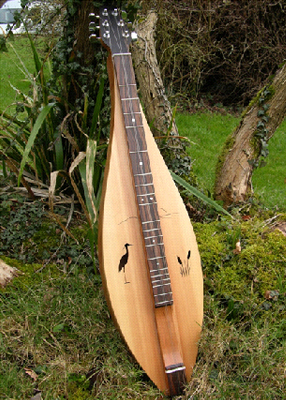Dulcimer Shapes & Designs
![]()
Most dulcimers come in two basic shapes:


Most people think of an hourglass shape and heart soundholes when they think of mountain dulcimers, because this was the combination popularised by revival makers such as Amburgey and Ledford, and players such as Jean Ritchie. Arguably, however, the single bout dulcimer shape is the earlier, not least because it was easy to make.
Teardrop dulcimers are supposedly louder, with a better bass response – although other factors such as size/volume of body probably have more influence. Hourglass dulcimers are said to have a more balanced sound, with two different size chambers for treble and bass response, but again, other design factors are probably more important determinants of the overall sound. Teardrop dulcimers are a little more difficult to balance on your lap, with a tendency to rotate around the narrow part of the body…but not a problem if you are using a strap or non-stick mat, as you should be!
![]()
Other elegant solutions include:


The fiddle-shaped dulcimer was popularised by Bill Davis from Tennessee, developed by his one-time apprentice Sam Carrell and continued by the modern maker Mike Clemmer. Its flat, large body produces volume with a well-balanced sound – the Carrell instruments are particularly attractive and I love them! The hourdrop (Warren A May) or aorell (Ron Ewing) tries to achieve the same balance by combining the bass response of the teardrop with the treble response of the hourglass – two different side shapes in one instrument. They work well, but it’s a shape you either love or loathe.
![]()
Some slightly less elegant solutions include:


This is really just a vibrating fingerboard with a big soundbox hung off it – in this case, literally a box. It used domestic carpentry, with no bending required, and simple parts which could be purchased from the local hardware store – screw hooks for tuners, fence staples for frets, tinplate for bridge and strum hollow etc. Surprisingly quiet, considering their internal volume.
![]()

Although there are twin-neck dulcimers – intended for a single player to have two different tunings available simultaneously – a courting dulcimer is meant for two players, sitting opposite each other, as in this 2012 picture of John Shaw and me in Bristol. The name alludes to the story that, in earlier times, this was an instrument that would allow courting couples to be alone together. Their protective parents could be assured that nothing untoward was happening as long as the music did not stop! For the record, John and I are just good friends…
![]()
The Dulcimer Family:
Finally, it’s worth knowing that there are actually five instruments in the dulcimer family, each playing at a different pitch. In other words, they have different standard playing ranges, rather like the violin, viola, cello and bass in the violin family. From high to low, they are as follows:
- Dulcimette – a small-bodied soprano dulcimer, playing an octave above standard and usually tuned dad. A specialism of master luthier Ron Ewing from Ohio.
- Baritone dulcimette – a mezzo-soprano dulcimer, playing an octave above a baritone dulcimer, usually tuned Aea. In 6 string form, sounds uncannily like an octave mandolin or mandola. Also a specialism of Ron Ewing. McSpadden make a smaller size 4 string Ginger model, usually tuned Gdgg, which does a similar job, but sounds more like a dulcimer.
- Standard dulcimer – as we know, generally tuned DAd.
- Baritone – a dulcimer playing at least 3 tones below a standard dulcimer, usually tuned AEA. It requires thicker strings and, ideally, a body constructed to take the extra tension from these heavy strings AND respond well to lower frequencies. The latter usually means a bigger body, i.e. a bigger volume of air which can respond better to lower frequencies (think double bass vs violin or the bass pipes of a church organ). Several makers have developed successful baritone dulcimers, including Ron Ewing (again), Blue Lion, Modern Mountain and McSpadden.
- Bass – a rarer dulcimer which plays an octave below the standard dulcimer, usually tuned DAD. As with the baritone, it requires heavier strings and a larger body. Blue Lion and McSpadden make this specialist model. As an interesting alternative, luthier David Beede has recently developed a solid-bodied, rubber-stringed dulcimer that actually plays in the range of a true double bass.
Each of these types of dulcimer is capable of playing its own solo repertoire, but most are used in dulcimer ensembles to provide a greater depth of sound. The lower instruments provide bass lines or counterpoint: the higher instruments can cut through and take the occasional lead line.
Picture courtesy of Ron Ewing Dulcimers
![]()
If you want to find out more about the different shapes and string configurations of dulcimer, try this page by Jerry Rockwell on the Sweet Music Index, hosted by Bear Meadow Dulcimers.

